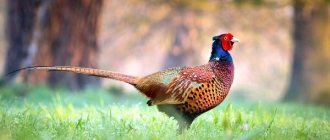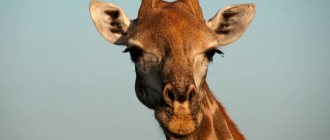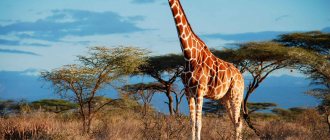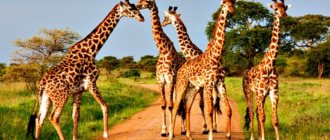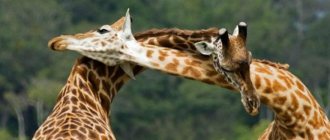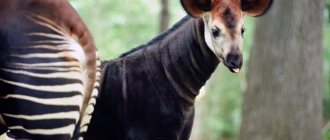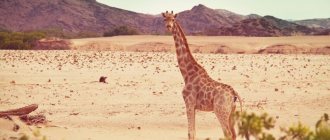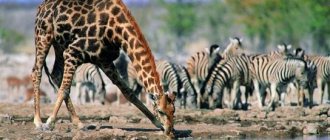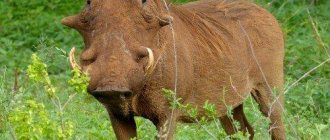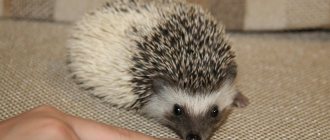Other meanings of this word:
- "Short" giraffe
- "Short-necked" giraffe
- "Ungrown" giraffe
- African short-necked giraffe
- African artiodactyl animal of the giraffe family
- Giraffe species
- Giraffe family animal
- animal of the giraffe family
- An animal that lives in the rainforests of the Congo Basin
- Giraffe
- Giraffe - meter with cap
- Striped giraffe
- Mini giraffe
- Giraffe from the "Red Book"
- jungle giraffe
- Giraffe like a zebra
- Giraffe is not in a “check”
- small giraffe
- Short stature giraffe
- Extra small giraffe
- giraffe from the shores of the Congo
- Short-necked giraffe
- Short-necked giraffe.
- giraffe with a zebra's rump
- Striped-thighed giraffe
- giraffe with short neck
- giraffe is slightly taller than a meter
- giraffe - meter with cap
- Giraffe, but he didn't grow tall
- The giraffe who “knows no better”
- A giraffe that didn't grow tall
- A giraffe that did not grow tall.
- Giraffe undersized
- Giraffe with no neck
- Giraffe that looks like a zebra
- Giraffe that didn't grow tall
- Shorty giraffe
- baby giraffe
- runt giraffe
- baby giraffe
- Giraffe is a minor.
- Junior giraffe
- Giraffe
- Giraffe with short neck
- Giraffe
- dwarf among giraffes
- Pygmy giraffe
- Short-legged giraffe
- Short-necked giraffe
- Shorty of giraffes
- Which giraffe is not tall enough?
- Forest giraffe
- Johnston's horse
- Little giraffe
- Smaller than a regular giraffe
- Meter-long giraffe
- mini giraffe
- Small giraffe
- short giraffe
- a short giraffe from the banks of the Congo
- A short giraffe from the shores of the Congo.
- Young giraffes
- Minor from the giraffe family
- undergrown giraffe
- Low giraffe
- Giraffe's little brother
- short giraffe
- A short giraffe.
- artiodactyl animal of the giraffe family
- An artiodactyl animal of the giraffe family that lives in the tropical forests of the Congo Basin
- Pigalitsa among giraffes
- Striped giraffe
- Midnight Giraffe
- Squat giraffe
- Rare African animal of the giraffe family
- rare animal from Africa
- Giraffe genus
- Genus of giraffes
- relative of the giraffe
- cropped giraffe
- Shortened giraffe.
Animals of Africa
Page 1 of 9
The African continent stretches from north to south for thousands of kilometers and has become home to many species of animals. The equator crosses it in the middle. The climate in Africa is warm and even hot.
The largest desert in the world, the Sahara, is located in northern Africa. In the summer it is very hot in the Sahara, there is practically no rain, which makes this area unsuitable for life. But here, too, many animals have found shelter, appearing after sunset to get food for themselves.
The Sahara is dominated by rocky and sandy deserts, where only some cereals and sedges, as well as thorny grasses and shrubs, can grow. Life is mainly concentrated in oases - places where there is water. Palm trees and moisture-loving plants grow in the oases, and birds chirp.
To the south of the Sahara there are savannas - steppe areas in which here and there you can see small groups of trees, among which baobabs are especially prominent. These trees, although relatively small in height, have a thick trunk reaching a diameter of 10 meters. The climate in savannas is seasonal: dry periods are replaced by rainy ones. The abundance of plant food in savannas attracts the attention of herbivorous animals, among which thousands of herds of antelope, buffalo, zebra, elephant, and giraffe predominate. They are hunted by lions, cheetahs, hyena dogs and leopards. Many birds live in savannas.
Different parts of the African savanna differ in soil type and water resources, and therefore in their flora and fauna. Four main zones can be distinguished with characteristic mammal species for each. dry savanna, wet savanna, scrub savanna and coastal forests.
Tropical rain forests grow in the equatorial part of Africa. It's warm and humid here. Every morning begins with bright sunshine, and by mid-day clouds gather and the sky pours with streams of rainwater. In such a climate, many plants thrive, forming dense, sometimes impenetrable forests in which a diverse fauna is found.
In Africa, 13 million km2 - almost half the continent - is dominated by herbaceous vegetation. In the old days, huge herds of grazing animals could be seen everywhere as far as the eye could see. The largest herds are now concentrated in national parks, mainly in the Serengeti, Tanzania, and Tsavo, Kenya. In the Serengeti, herds of wildebeest number up to 50,000 animals (wildebeest are also called "wildebest", which means "wild bull" in Afrikaans, but is actually an antelope). Together with the wildebeest, up to a million Thomson's gazelles and 200,000 zebras roam.
Although all herbivores eat grass, not all of them compete for food. Zebras, for example, eat tall grasses to a certain level, and wildebeest nibble grass where zebras have already been, as well as fresh growth that appears after rain.
African lion
I call Leo the king of beasts. The weight of a large predator reaches 280 kg. With a blow of their paw they break the buffalo's spine. Lions' fangs are relatively short but powerful. The body is covered with short hair, and only males have a luxurious mane. In fights between males, this mane protects them from blows from their opponents. The skin of lions is very durable; it was not for nothing that in the old days warriors used it as armor or pulled it over their shield.
Currently, lions remain only in sub-Saharan Africa, and there is a small population of lions in India.
Lions live in family groups. Several females and young lions stay around the male. Some adult males live alone. At night, the terrifying roars of males are heard in the savannahs. In this way, they make it clear to other lions that the territory is occupied and has an owner.
Sixteen hours a day, lions sleep or bask under the shade of trees. Hunting is the destiny of lionesses. Their prey is large animals: antelopes, zebras, buffalos. After a successful hunt, the male is the first to approach the prey, dispersing the females. Everyone waits until he is satisfied, and only then do the rest of the group start eating.
Leopard
This common predator in Africa lives in savanna, desert and virgin forests. People, however, have driven the leopard out of many of its habitats. His hunting tactics depend on the prey he is lying in wait for. Hunting for small mammals, it quickly attacks, chasing a larger animal, the leopard sneaks up unnoticed and delivers a sudden blow with a powerful paw. It eats small prey immediately, but drags the bodies of large animals up a tree and feeds on their meat for several days. The size of his hunting territory depends on the amount of prey on it.
Leopards always live alone. Males and females meet only during the mating season, and then immediately disperse, and the female raises her offspring herself.
Dune cat
Living in the Sahara and the deserts of the Arabian Peninsula, the sand cat never drinks water, quenching its thirst with the blood of its victims. The small sand cat has large ears and faded fur, which is typical of all desert dwellers. It lives in both sandy and rocky areas of the Sahara. She has a wide, flat head, and she can watch her prey, hiding behind the dunes, where she is completely out of sight.
It feeds on small rodents: gerbils and ground squirrels. The sand cat also eats scorpions, reptiles and insects. Together with the fennec fox and the African leopard, it is one of the few carnivores that can exist in deserts. Her paws are covered with fur, so she doesn't sink into the sand. She has very acute hearing, she can hear even the quietest movements of rodents in the sand. The cat spends the day in a cave, where another desert inhabitant, the fennec, often lives with it. The cat goes hunting when the temperature drops and the air becomes cooler.
Zebra
There are three species of zebras in Africa. Grevy's zebra has the narrowest thigh stripes of any species. The number of zebras is constantly declining, and small scattered groups remain from the once large herds.
Zebras are one of the most numerous animal tribes in the African steppe, the closest relative of horses and donkeys. Herds of striped horses cross the expanse in all directions, looking for lush pastures and at the same time solving family matters along the way. A zebra family is a harem with a single ruler at its head. Male foals are doomed to expulsion and further struggle for their own set of females. The zebra is one of the most flexible inhabitants of the savannah. Striped horses willingly put up with other animals, forming mixed herds, most often with antelopes.
A mixed herd, consisting of animals of different species, has a number of other advantages. For example, if zebras and wildebeest are joined by ostriches, for whom their keen eyes and long necks provide periscope vision, the ungulates can no longer rely only on their subtle sense of smell.
Aardvark
The African animal aardvark can be considered a record holder for high-speed digging. With the help of powerful paws and long, spoon-shaped claws, the aardvark can dig a hole in soft soil faster than several people armed with shovels can dig a trench of the same length.
The aardvark is not capable of fleeing from enemies; he is too clumsy for this. But he can hide from danger in a hole that he will instantly dig for this purpose. In five minutes, the animal sometimes manages to dig a passage several meters long. Even hard soil, dried by the scorching sun, yields to the efforts of the aardvark, unless the work is delayed for a longer period. Baby aardvarks begin digging their own tunnels in the ground when they reach 6 months of age. When digging tunnels, the aardvark presses its ears to its head and closes its nostrils - this is necessary so that soil does not accumulate there and ants and termites do not crawl in.
African buffalo
The Kaffir buffalo is a powerful African bull. The weight of the animal exceeds 1000 kg. Both males and females have horns. The horns are powerful, curved, their bases close together to form a wide frontal helmet.
Aware of his strength, the large buffalo feels completely safe. Not every predator will dare to attack him. When meeting a lion or leopard, a buffalo, bowing its head and putting its horns forward, boldly rushes at the predator. He will not tolerate closeness to a person. It is not uncommon for buffalo to ram the cars of annoying visitors to national parks.
Scorpios
These sand-colored arachnids live in deserts and other dry areas. At night they go out to hunt for insects, lizards, small rodents and other prey.
The sting with poison at the end of the abdomen serves scorpions primarily for protection. Scorpions use poison only if the prey offers too active resistance, and also if the victim is too large. The venom of some scorpions is strong enough to kill a person. However, Scorpios are extremely secretive. During the day, they look for a damp place and hide in rock crevices or the homes of other animals.
Jackson's Chameleon
This is one of the largest chameleons in the world. The length of the male reaches 30 cm, and the female is slightly smaller - up to 25 cm. Jackson's chameleons live in the forested mountains of Tanzania and Kenya, but they can often be found in forest parks. They are green with yellow stripes and, like all chameleons, change color to suit their environment.
The male has three horns, with which he fights other males. Some females also have horns, but they are much smaller than those of males. Chameleons feed on insects, other invertebrates and frogs. They catch prey with the help of a sticky tongue, the length of which is one and a half times the length of the chameleon’s body, and which they quickly throw out of their mouth.
- To the begining
- Back
- 1
- Forward
- In the end
